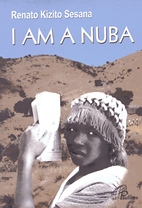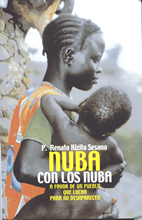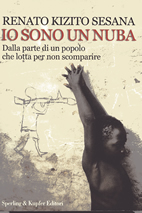


Renato Kizito Sesana, a Comboni Missionary, is the author of “I am a Nuba”, published in Italian (Milan, 2004, Sperling & Kupfer Editori) in Spanish (Madrid, 2006, Editorial Mundo Negro) and in English (Nairobi, 2006, Paulines Publications Africa). It can be bought online from us.Here we publish the Introduction and the Prologue of the English version.
Introduction
In the Nuba Mountains, war has ended. People move freely; in the markets one can find the essential commodities. As for the rest, almost two years after the signing of the peace treaty, it is becoming increasingly clear that the SPLA has abandoned us and we are the true losers of the peace treaty.” The person talking to me prefers to remain unnamed. He belongs to the Nuba people and used to hold a prominent position in the Sudan People’s Liberation Army but, some months ago, he chose exile. He says that he doesn’t want to be part of a corrupt local government that has betrayed the promises of the long years of warfare. For years, this person has put his life at risk in the resistance against the Khartoum government but now that, at last, there is peace, he is in Nairobi and moves between the embassies of Western countries, in the hope of finding resettlement in one of them.
His disappointment is shared by many Nuba. The Nuba have contributed much to the SPLA cause. In the period from 1989 till 2002, thousands of their young men went to fight in the South, giving a very remarkable contribution to the resistance against the oppressive Khartoum government and to the building up of South Sudan. Moreover, for years, they have been a bulwark against the imposition of the Muslim fundamentalism coming from the North. Their position is strategically important geographically – being in the North but close to the South – and from the political and religious points of view because they are a people, for the majority, Islamized and yet who have been resisting the imposition of Islam and of Sharia’h Law. They are a fiercely independent people and do not accept orders from anybody, even from their co-faithful. This made them the subject of cruel government repressions, the last of which was the attack unleashed in May 2001.
But to understand the Nuba, we have to put their struggle in the context of the history of their country, the Sudan. The roots of the conflict are profound, going deep into the cultural, social, political and religious differences between the North and the South. On one side stand the peoples of the North, who consider themselves “Arabs”, even though in reality they were arabised in relatively recent times, and who constitute roughly two thirds of the total population of the country. On the other side, in the South, there are peoples of nilotic origin, with cultures and languages strictly linked with Black Africa. These two great human groups have been in conflict for centuries, one of the causes of the conflict being slavery, mainly practiced by the North against the South. Yet the British colonialists put them together in a country called Sudan.
The first phase of the Sudan civil war started on 18 August 1955, a few months before independence, which came on 1 January 1956. It was a very low intensity war, and the rebels did not succeed to control any significant area or establish a separate administration. It was concluded in 1972, with the Addis Ababa Agreement, and followed by a period of broken promises by the Khartoum Government, so that the southerners felt there was no other alternative that to restart the war. Which happened in May 1983, under the banner of SPLM/A, an armed movement born, in the spirit of those days, as Marxist-Leninist and supported by USSR, China and Cuba. In a slow change of alliances, after 1989 the SPLA, and in particular its leader John Garang, became a faithful ally of the Americans, who already in the mid-nineties, used the SPLA as a barrier to control the Arabo Islamic expansionism. In this process the United States gave to Garang blind economic and military support in spite of the very undemocratic practices, to say the least, going on inside the movement, therefore fostering a dictatorial drift.
When the peace talks started in mid 2004, the two parties claiming to represent the North and the South had no clear mandate. In Khartoum Omar el Bashir, had seized power with a coup d’etat in 1989, suppressing every opposition, and in the South the strict control of Garang and his Dinka people had successfully made impossible to hear any dissenting voice. I believe that one of the reasons why the two parties were so reluctant to sit around a negotiation table, was precisely the fact that both were aware of their scant popular support, and that in the event of the implementation of truly free and fair election, this could come to light.
In this intricate situation, with military and political leaders that had switched allegiances several times, and a heavy external interference for making peace, any kind of peace, fast, other factors contributed in complicating the general picture.
Firstly, in September 1999 the Khartoum government succeeded in putting into exploitation – with the support of Chinese and Canadian companies – a number of oil wells geographically situated in the South but that have always been firmly in its hands. The income from these wells has put in the hands of the government a wealth that has changed the nature of the civil war, allowing it to buy weapons in quantities and qualities that it could never afford before.
Secondly, after 9/11, to avoid the danger of being listed as a rogue state, the Sudan government tried to appease the United States choosing a line of very cautious collaboration, giving out information on the Islamic extremists that had used Sudan as a base in the early nineties, and finally agreeing to peace talks, under the eager and vigilant supervision of the Americans.
Thirdly, as Khartoum’s attitude became softer, in the United States the “religious right”, having one of their own as President, became harder and bolder in demanding action against Khartoum. They started a campaign that, if it had the merit of keeping the international attention focused on Sudan, it has a visceral and unreasonable anti-Islamic attitude that has contributed in making people perceive the Sudan civil war as a religious war (I do not believe this to be true. I believe that the root cause of the Sudan civil war is lack of basic human rights for the Southerners), and has exacerbated the conflict, undermining the possibility of a religious peaceful coexistence for many years to come.
And why has the Bush administration wanted peace at any cost in Sudan, forcing, literally under duress, the two parties to sit around a negotiating table? The idea was that an American sponsored peace in Sudan would enormously enhance American prestige in this part of Africa, defuse the terrorism threat, create economic opportunities for the United States in the area, and show to the world that America could be a peace maker, not only a war wager. Unfortunately, as it has happened so many times with United States initiatives in this part of the world even when moved by the best intentions, the vision was not matched by a deep understanding of the situation on the ground, and things went awry.
In all these intricacies – and we have not even mentioned the interests of the countries bordering Sudan, another cause of complications – the peace process seemed to have lost the fundamental reason of the civil war, that is the vindication of the basic human rights by the non-Arabized peoples. Now, almost two years after the signing of the Comprehensive Peace Agreement in Nairobi on January 9 2005, the risk is that a peace, imposed from on high on two parties that did not fully represent the people, has not answered the legitimate demands of the people who have fought and given their lives for their homeland.
In this picture, the Nuba have always counted little within the liberation movement, notwithstanding their undisputed faithfulness to the SPLM/A. The SPLM/A revived the Nuba issue when it wanted to slow down or block negotiations with the Khartoum government, because it knew that the government was not ready to put into question the belonging of the Nuba to the North of the Sudan. But apart from these few moments of notoriety, the Nuba were always marginalized even within the SPLM/A.
It was, therefore, a big surprise when, in January 2002, the Nuba representatives, apparently with the mandate of the SPLA leadership, signed a ceasefire with the Khartoum government. Suddenly the Nuba became the experimentation field of a possible peace, and politically their cause became central in the dispute about the Sudanese civil war. But it didn’t last long. The ceasefire in the Nuba Mountains, as it became clear in May of the same year, was only the first step to start the peace process imposed on both sides by the international community, in particular the US. Once more, the Nuba had been used as an experimental field, or as bait.
In the bulletin published at the end of the first round of the peace negotiations, which took place at Machakos (Kenya) in mid 2004, the situation of the Nuba Mountains and the “twin” area – the Southern Blue Nile – was not even mentioned. In those days the impression was that peace was going to be attained in a few weeks time. Instead, the peace agreement was reluctantly signed by both parties only in January 2005, also because the SPLA, which in July 2002 was not yet ready for peace, once more, as a way to slow down the negotiation, rediscovered the Nuba issue and for a few months made it central to the whole question of peace.
But again, with the increasing pressure for the peace treaty to be signed, the Nuba cause was sidestepped. The Comprehensive Peace Agreement (CPA) of January 9, 2005, although foreseeing “autonomy” for the Nuba, the terms of which are not specified, inserts them into the North without the possibility of a choice. They will not be allowed to take part in the referendum about the choice to remain united with the North or to separate. In the CPA, there is the possibility for the local Nuba parliament to pass laws with autonomy about topics that do not touch the general principles of the Constitution, about local items of minor importance, but the terms are not specified as well as the mandate of the vague “popular consultations” that are supposed to ratify these changes.
Was it worthwhile to undergo persecutions, to become the target of a real genocide, to lose thousands of lives defending the rights of the South in order to get so little? “Nothing, even” as the person who speaks with me specifies. At the moment, the Nuba are still savouring the relief of peace, with its unquestionable advantages, but the dissatisfaction is already creeping in, the more everybody realizes that peace will not allow the Nuba any form of self-determination. It is a morsel difficult to swallow by those who have set up a resistance that has had a terrible cost in terms of sacrifices and lost of human lives.
If one broadens the view to the whole of Sudan, the fear is that the forces that unleashed the civil war more than twenty years ago, and those responsible for the clashes in Darfur since the end of 2002, may not be able to control the consequences of the war they have fuelled, and that we might have to witness the progressive fragmentation of this largest country of Africa.
Yes, Darfur. Is it just coincidence that the clashes in Darfur started a few months after the beginning of the peace negotiations in Kenya? Previously this was a sleepy area that the SPLM/A had unsuccessfully tried to mobilize against the goverment. What has happended that has changed the situation so dramatically? Is it true that Darfur has enormous potential for oil? Who has sold or donated the weapons to the rebels? Who is supporting them? Chad? No jokes, please. Certainly the present Khartoum government – including the SPLM/A – is deeply responsible for what is happineg there. But somebody else is responsibile and we will not know who to blame unless we get the answers to the above questions.
In the meantime, in the South, the episodes of inter-ethnic violence continue; and in the East, among the Beja, everybody feels the threat of intensifying clashes. Only in Khartoum, Kosti, El Obeid, Port Sudan, the central government is firmly in control of the situation and is implementing development plans with alacrity. In the South, the almost total absence of cadres able to manage a new state, as well as the absence of a true leadership and a shared vision about the future of the whole area, seems to prepare the nightmare of a state in which programmes are planned and implemented by big international NGOs, whereas the local government is inefficient and corrupt.
Those who have the future of the great country at heart, hope that the impending danger of progressive disintegration will be stopped by strong political actions that will re-affirm its unity. It is necessary to give content to peace, e.g. the dignity and respect for human rights, the overcoming of extreme poverty, the construction of schools and hospitals. It is an enormous task, but it is a task that everybody must undertake – the government, the civil society, the churches, the local and international NGOs – to avoid falling into an abyss.
Father Renato Kizito Sesana,
Comboni Missionary
Nairobi, 12 November 2006
Prologue
Father, I’ve heard about you. They say you often travel to Sudan. I know you’ve been to Leer… why don’t you come to the Nuba Mountains? There are many Catholics there in need of a priest, and many boys in need of schools.”
The speaker was Yousif Kuwa, sitting before me in my Kilimani Road office, Nairobi, early in January 1994. I no longer hoped in such a proposal, “Why don’t you come to the Nuba Mountains?”
Kuwa, a Muslim, was the head of the SPLM (Sudan Peoples Liberation Movement) as well as a commander in the SPLA (Sudan Peoples Liberation Army), its military wing, for the Nuba Mountains. I was a missionary based in Nairobi, operating a youth community centre and in charge of a Catholic magazine. The Nuba people lived on the mountains made famous by Leni Riefenstahl. She had taken shots of their spectacular fights, painted bodies and colourful dances. She had been Hitler’s photographer, and had been in search of the Nuba in imitation of George Rodger, another famous photographer. In the 1970s I had come across a book of Leni’s photographs, and had developed a strong wish to know that rather heterogeneous nation and be a missionary in their midst.
The Nuba still bore in their flesh a long, and by no means concluded, history of slavery. They had succeeded in carving out for themselves an extraordinary habitat of mountain and hill tops, which is not usual on the continent. The reason was to escape the slave-raiding caravans from El Obeid, capital of the Kordofan, which in the 1800s was an important slave market. Daniel Comboni, our founder, had himself dreamed of evangelising them personally. A few months before he died, in 1881, he went “to have a look at the Nuba people, ruined by slavery and 90% destroyed.” Khartoum, where he penned those words, was the see of the huge Vicariate for Central Africa. The full report of that trip is lost, but in some of his letters Comboni spoke of the Nuba territory as a promising one: “Men and women go naked here as in Kic, but they look more vigorous and ready for evangelization.”
The Nuba were the victims of a silent but real enough genocide, perpetrated for years. It was a cultural and genetic massacre-taking place in the context of the longest African war. Following ferocious raids, the government enclosed the prisoners in so-called “peace camps.” Men, women and children were mixed together after dismembering the family units, as a result of a jihad of Muslims against a largely Muslim people. It was a clear case of ethnic cleansing.
To get there on my own was a most difficult endeavour. But I couldn’t say “no” to Yousif Kuwa after such a formal invitation. I began preparations.



